Healthcare Education Research: Methodology Project Analysis
VerifiedAdded on 2023/04/26
|7
|1479
|201
Project
AI Summary
This document outlines the research methodology employed in a healthcare education project. The study utilizes a qualitative approach, primarily relying on surveys to examine the effectiveness of interprofessional education among healthcare professionals from various disciplines, including physiotherapy, occupational therapy, medicine, dietetics, and others. The research employs a longitudinal, quasi-experimental design with two cohorts, one with prior interprofessional education experience and one without. Data collection involves surveys at multiple time points, and the data analysis incorporates both quantitative and qualitative techniques, such as t-tests, variance analysis, and template analysis, to compare the impact of interprofessional education on team skills and attitudes toward healthcare teams. The document also includes a detailed methodology section, references, and a figure summarizing the study's design.

Running head: METHODOLOGY
Methodology
Name of the Student:
Name of the University:
Author Note:
Methodology
Name of the Student:
Name of the University:
Author Note:
Paraphrase This Document
Need a fresh take? Get an instant paraphrase of this document with our AI Paraphraser
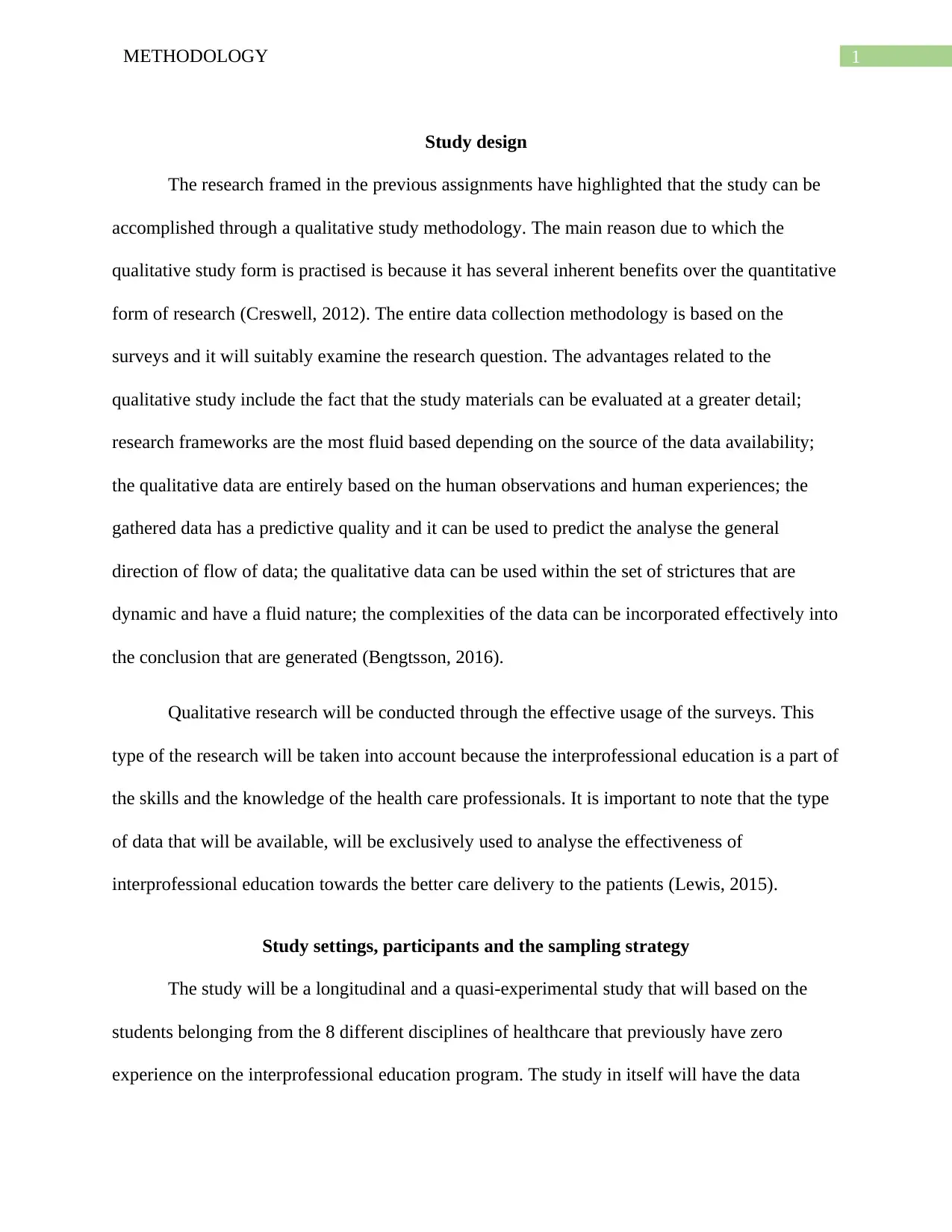
1METHODOLOGY
Study design
The research framed in the previous assignments have highlighted that the study can be
accomplished through a qualitative study methodology. The main reason due to which the
qualitative study form is practised is because it has several inherent benefits over the quantitative
form of research (Creswell, 2012). The entire data collection methodology is based on the
surveys and it will suitably examine the research question. The advantages related to the
qualitative study include the fact that the study materials can be evaluated at a greater detail;
research frameworks are the most fluid based depending on the source of the data availability;
the qualitative data are entirely based on the human observations and human experiences; the
gathered data has a predictive quality and it can be used to predict the analyse the general
direction of flow of data; the qualitative data can be used within the set of strictures that are
dynamic and have a fluid nature; the complexities of the data can be incorporated effectively into
the conclusion that are generated (Bengtsson, 2016).
Qualitative research will be conducted through the effective usage of the surveys. This
type of the research will be taken into account because the interprofessional education is a part of
the skills and the knowledge of the health care professionals. It is important to note that the type
of data that will be available, will be exclusively used to analyse the effectiveness of
interprofessional education towards the better care delivery to the patients (Lewis, 2015).
Study settings, participants and the sampling strategy
The study will be a longitudinal and a quasi-experimental study that will based on the
students belonging from the 8 different disciplines of healthcare that previously have zero
experience on the interprofessional education program. The study in itself will have the data
Study design
The research framed in the previous assignments have highlighted that the study can be
accomplished through a qualitative study methodology. The main reason due to which the
qualitative study form is practised is because it has several inherent benefits over the quantitative
form of research (Creswell, 2012). The entire data collection methodology is based on the
surveys and it will suitably examine the research question. The advantages related to the
qualitative study include the fact that the study materials can be evaluated at a greater detail;
research frameworks are the most fluid based depending on the source of the data availability;
the qualitative data are entirely based on the human observations and human experiences; the
gathered data has a predictive quality and it can be used to predict the analyse the general
direction of flow of data; the qualitative data can be used within the set of strictures that are
dynamic and have a fluid nature; the complexities of the data can be incorporated effectively into
the conclusion that are generated (Bengtsson, 2016).
Qualitative research will be conducted through the effective usage of the surveys. This
type of the research will be taken into account because the interprofessional education is a part of
the skills and the knowledge of the health care professionals. It is important to note that the type
of data that will be available, will be exclusively used to analyse the effectiveness of
interprofessional education towards the better care delivery to the patients (Lewis, 2015).
Study settings, participants and the sampling strategy
The study will be a longitudinal and a quasi-experimental study that will based on the
students belonging from the 8 different disciplines of healthcare that previously have zero
experience on the interprofessional education program. The study in itself will have the data
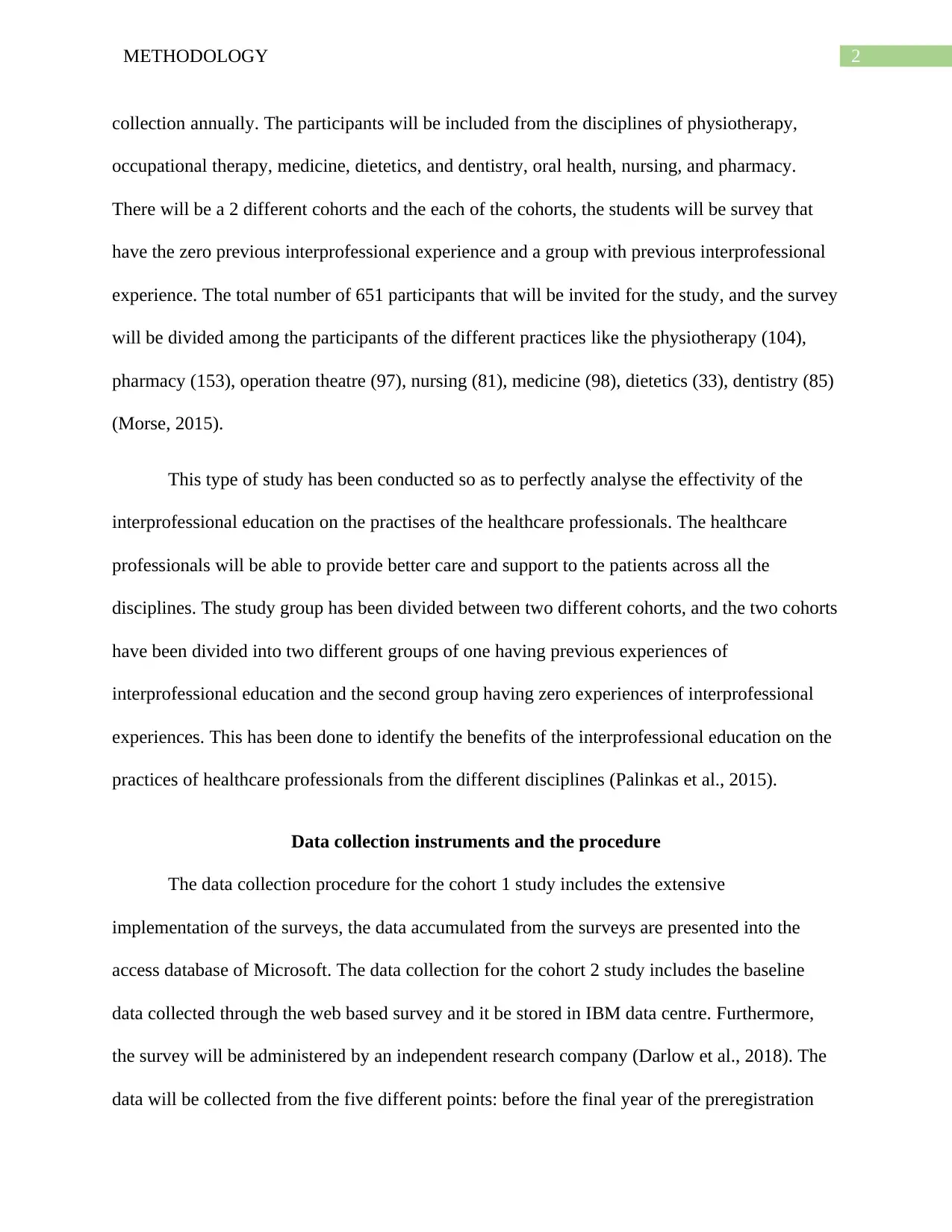
2METHODOLOGY
collection annually. The participants will be included from the disciplines of physiotherapy,
occupational therapy, medicine, dietetics, and dentistry, oral health, nursing, and pharmacy.
There will be a 2 different cohorts and the each of the cohorts, the students will be survey that
have the zero previous interprofessional experience and a group with previous interprofessional
experience. The total number of 651 participants that will be invited for the study, and the survey
will be divided among the participants of the different practices like the physiotherapy (104),
pharmacy (153), operation theatre (97), nursing (81), medicine (98), dietetics (33), dentistry (85)
(Morse, 2015).
This type of study has been conducted so as to perfectly analyse the effectivity of the
interprofessional education on the practises of the healthcare professionals. The healthcare
professionals will be able to provide better care and support to the patients across all the
disciplines. The study group has been divided between two different cohorts, and the two cohorts
have been divided into two different groups of one having previous experiences of
interprofessional education and the second group having zero experiences of interprofessional
experiences. This has been done to identify the benefits of the interprofessional education on the
practices of healthcare professionals from the different disciplines (Palinkas et al., 2015).
Data collection instruments and the procedure
The data collection procedure for the cohort 1 study includes the extensive
implementation of the surveys, the data accumulated from the surveys are presented into the
access database of Microsoft. The data collection for the cohort 2 study includes the baseline
data collected through the web based survey and it be stored in IBM data centre. Furthermore,
the survey will be administered by an independent research company (Darlow et al., 2018). The
data will be collected from the five different points: before the final year of the preregistration
collection annually. The participants will be included from the disciplines of physiotherapy,
occupational therapy, medicine, dietetics, and dentistry, oral health, nursing, and pharmacy.
There will be a 2 different cohorts and the each of the cohorts, the students will be survey that
have the zero previous interprofessional experience and a group with previous interprofessional
experience. The total number of 651 participants that will be invited for the study, and the survey
will be divided among the participants of the different practices like the physiotherapy (104),
pharmacy (153), operation theatre (97), nursing (81), medicine (98), dietetics (33), dentistry (85)
(Morse, 2015).
This type of study has been conducted so as to perfectly analyse the effectivity of the
interprofessional education on the practises of the healthcare professionals. The healthcare
professionals will be able to provide better care and support to the patients across all the
disciplines. The study group has been divided between two different cohorts, and the two cohorts
have been divided into two different groups of one having previous experiences of
interprofessional education and the second group having zero experiences of interprofessional
experiences. This has been done to identify the benefits of the interprofessional education on the
practices of healthcare professionals from the different disciplines (Palinkas et al., 2015).
Data collection instruments and the procedure
The data collection procedure for the cohort 1 study includes the extensive
implementation of the surveys, the data accumulated from the surveys are presented into the
access database of Microsoft. The data collection for the cohort 2 study includes the baseline
data collected through the web based survey and it be stored in IBM data centre. Furthermore,
the survey will be administered by an independent research company (Darlow et al., 2018). The
data will be collected from the five different points: before the final year of the preregistration
⊘ This is a preview!⊘
Do you want full access?
Subscribe today to unlock all pages.

Trusted by 1+ million students worldwide
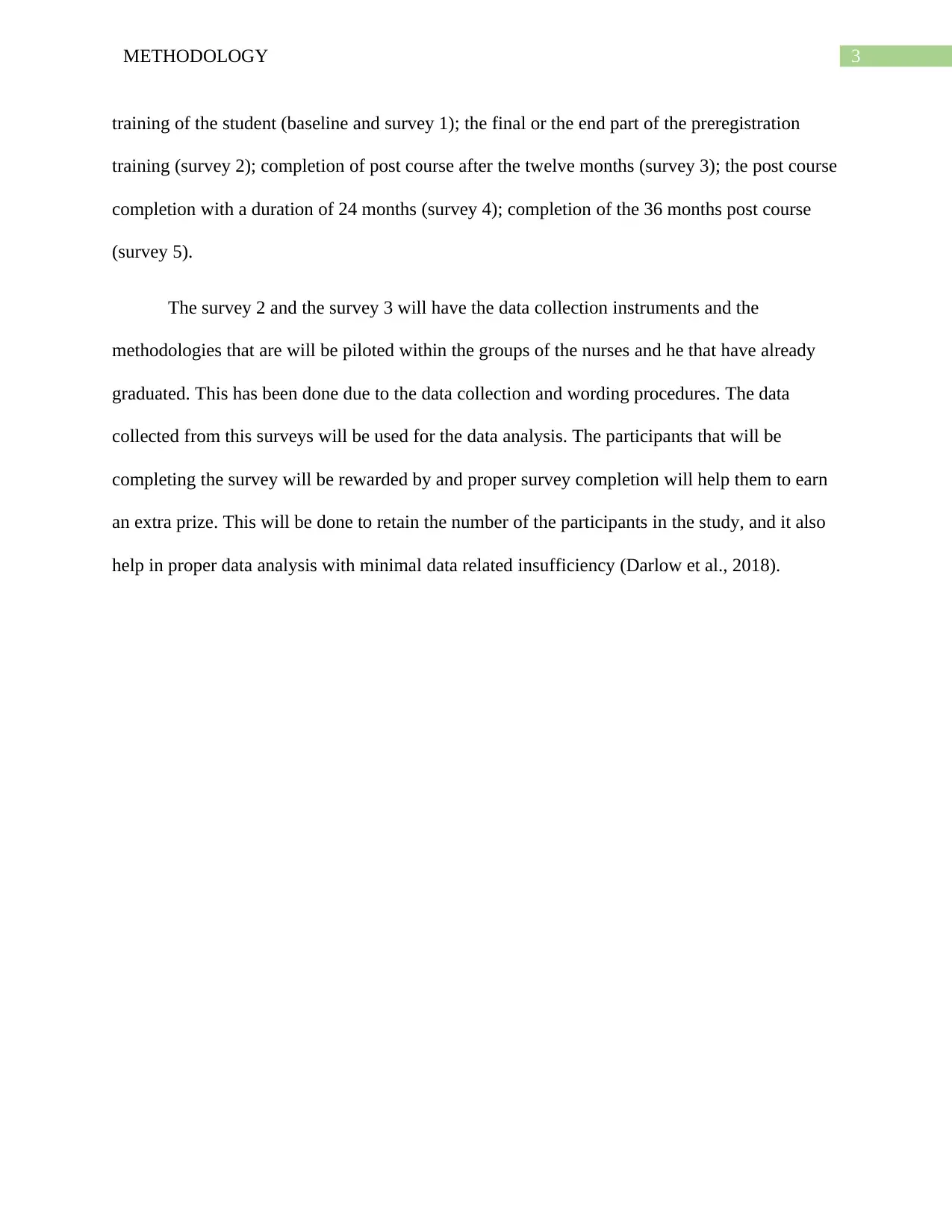
3METHODOLOGY
training of the student (baseline and survey 1); the final or the end part of the preregistration
training (survey 2); completion of post course after the twelve months (survey 3); the post course
completion with a duration of 24 months (survey 4); completion of the 36 months post course
(survey 5).
The survey 2 and the survey 3 will have the data collection instruments and the
methodologies that are will be piloted within the groups of the nurses and he that have already
graduated. This has been done due to the data collection and wording procedures. The data
collected from this surveys will be used for the data analysis. The participants that will be
completing the survey will be rewarded by and proper survey completion will help them to earn
an extra prize. This will be done to retain the number of the participants in the study, and it also
help in proper data analysis with minimal data related insufficiency (Darlow et al., 2018).
training of the student (baseline and survey 1); the final or the end part of the preregistration
training (survey 2); completion of post course after the twelve months (survey 3); the post course
completion with a duration of 24 months (survey 4); completion of the 36 months post course
(survey 5).
The survey 2 and the survey 3 will have the data collection instruments and the
methodologies that are will be piloted within the groups of the nurses and he that have already
graduated. This has been done due to the data collection and wording procedures. The data
collected from this surveys will be used for the data analysis. The participants that will be
completing the survey will be rewarded by and proper survey completion will help them to earn
an extra prize. This will be done to retain the number of the participants in the study, and it also
help in proper data analysis with minimal data related insufficiency (Darlow et al., 2018).
Paraphrase This Document
Need a fresh take? Get an instant paraphrase of this document with our AI Paraphraser
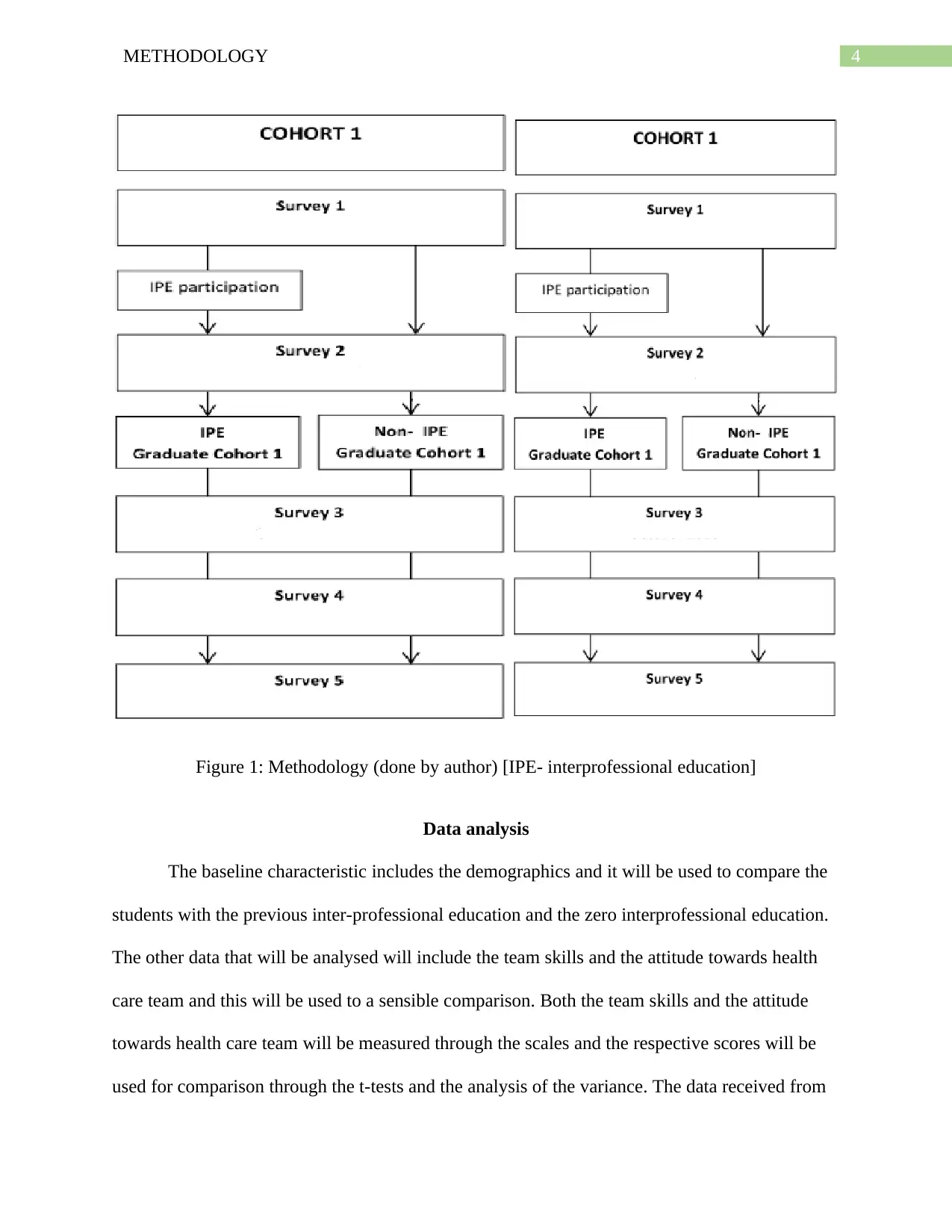
4METHODOLOGY
Figure 1: Methodology (done by author) [IPE- interprofessional education]
Data analysis
The baseline characteristic includes the demographics and it will be used to compare the
students with the previous inter-professional education and the zero interprofessional education.
The other data that will be analysed will include the team skills and the attitude towards health
care team and this will be used to a sensible comparison. Both the team skills and the attitude
towards health care team will be measured through the scales and the respective scores will be
used for comparison through the t-tests and the analysis of the variance. The data received from
Figure 1: Methodology (done by author) [IPE- interprofessional education]
Data analysis
The baseline characteristic includes the demographics and it will be used to compare the
students with the previous inter-professional education and the zero interprofessional education.
The other data that will be analysed will include the team skills and the attitude towards health
care team and this will be used to a sensible comparison. Both the team skills and the attitude
towards health care team will be measured through the scales and the respective scores will be
used for comparison through the t-tests and the analysis of the variance. The data received from
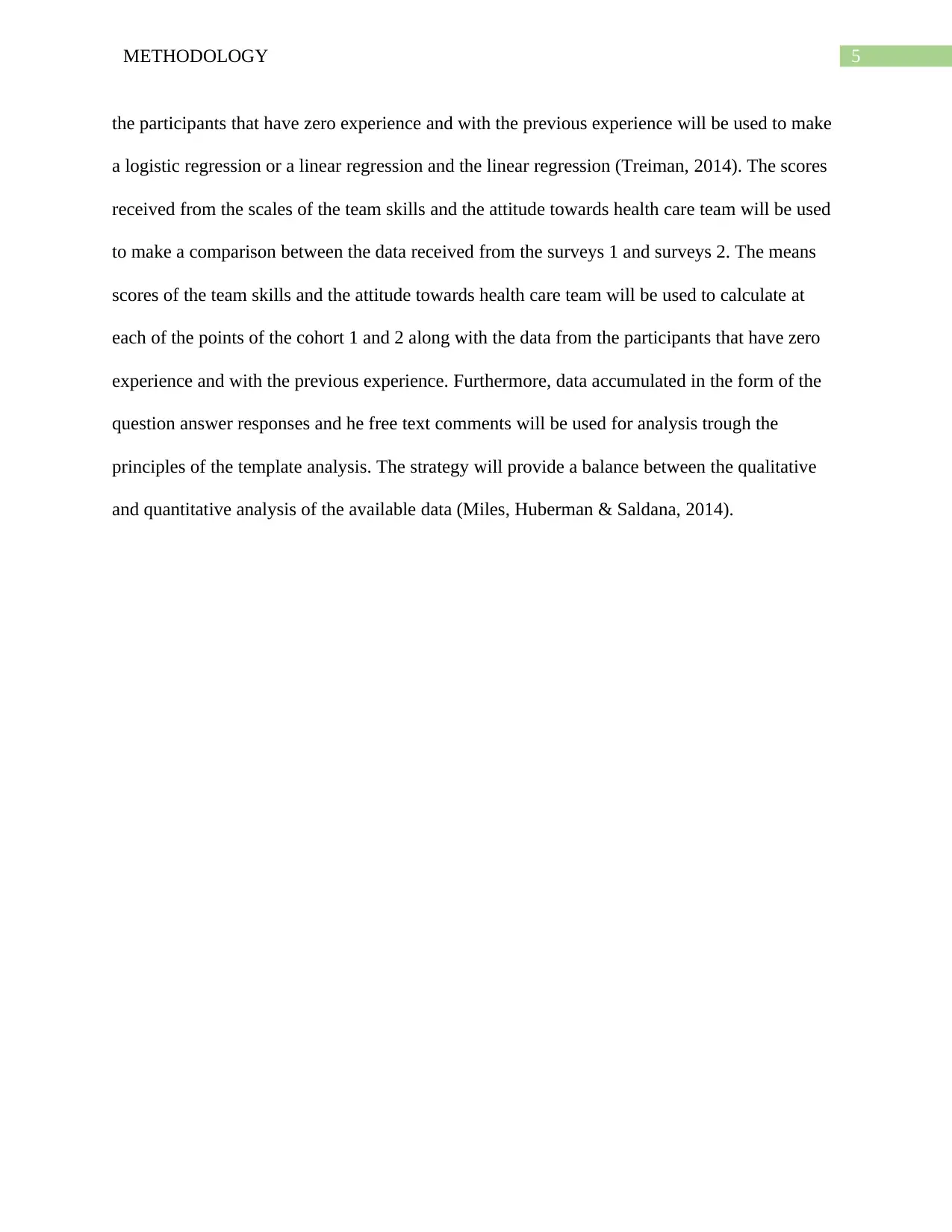
5METHODOLOGY
the participants that have zero experience and with the previous experience will be used to make
a logistic regression or a linear regression and the linear regression (Treiman, 2014). The scores
received from the scales of the team skills and the attitude towards health care team will be used
to make a comparison between the data received from the surveys 1 and surveys 2. The means
scores of the team skills and the attitude towards health care team will be used to calculate at
each of the points of the cohort 1 and 2 along with the data from the participants that have zero
experience and with the previous experience. Furthermore, data accumulated in the form of the
question answer responses and he free text comments will be used for analysis trough the
principles of the template analysis. The strategy will provide a balance between the qualitative
and quantitative analysis of the available data (Miles, Huberman & Saldana, 2014).
the participants that have zero experience and with the previous experience will be used to make
a logistic regression or a linear regression and the linear regression (Treiman, 2014). The scores
received from the scales of the team skills and the attitude towards health care team will be used
to make a comparison between the data received from the surveys 1 and surveys 2. The means
scores of the team skills and the attitude towards health care team will be used to calculate at
each of the points of the cohort 1 and 2 along with the data from the participants that have zero
experience and with the previous experience. Furthermore, data accumulated in the form of the
question answer responses and he free text comments will be used for analysis trough the
principles of the template analysis. The strategy will provide a balance between the qualitative
and quantitative analysis of the available data (Miles, Huberman & Saldana, 2014).
⊘ This is a preview!⊘
Do you want full access?
Subscribe today to unlock all pages.

Trusted by 1+ million students worldwide
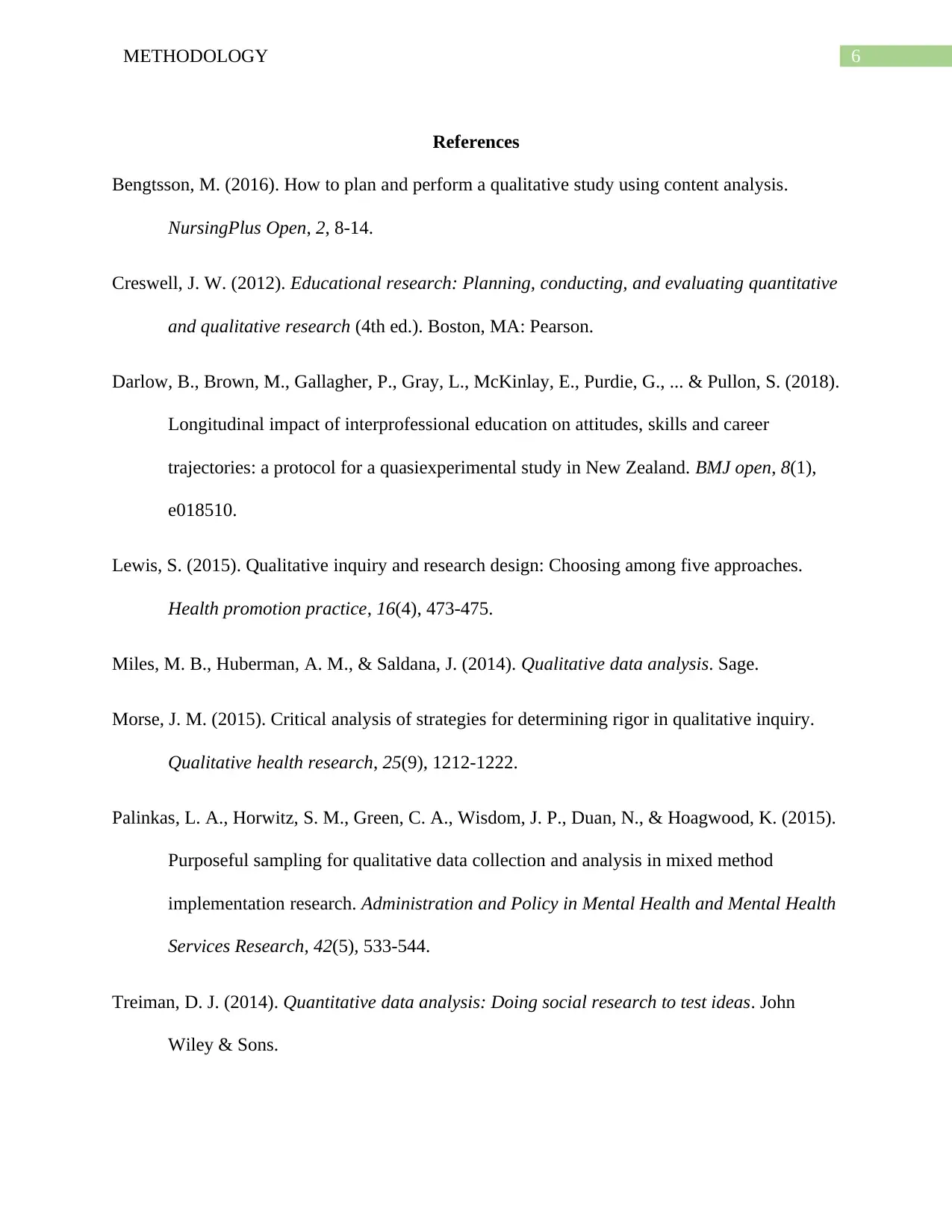
6METHODOLOGY
References
Bengtsson, M. (2016). How to plan and perform a qualitative study using content analysis.
NursingPlus Open, 2, 8-14.
Creswell, J. W. (2012). Educational research: Planning, conducting, and evaluating quantitative
and qualitative research (4th ed.). Boston, MA: Pearson.
Darlow, B., Brown, M., Gallagher, P., Gray, L., McKinlay, E., Purdie, G., ... & Pullon, S. (2018).
Longitudinal impact of interprofessional education on attitudes, skills and career
trajectories: a protocol for a quasiexperimental study in New Zealand. BMJ open, 8(1),
e018510.
Lewis, S. (2015). Qualitative inquiry and research design: Choosing among five approaches.
Health promotion practice, 16(4), 473-475.
Miles, M. B., Huberman, A. M., & Saldana, J. (2014). Qualitative data analysis. Sage.
Morse, J. M. (2015). Critical analysis of strategies for determining rigor in qualitative inquiry.
Qualitative health research, 25(9), 1212-1222.
Palinkas, L. A., Horwitz, S. M., Green, C. A., Wisdom, J. P., Duan, N., & Hoagwood, K. (2015).
Purposeful sampling for qualitative data collection and analysis in mixed method
implementation research. Administration and Policy in Mental Health and Mental Health
Services Research, 42(5), 533-544.
Treiman, D. J. (2014). Quantitative data analysis: Doing social research to test ideas. John
Wiley & Sons.
References
Bengtsson, M. (2016). How to plan and perform a qualitative study using content analysis.
NursingPlus Open, 2, 8-14.
Creswell, J. W. (2012). Educational research: Planning, conducting, and evaluating quantitative
and qualitative research (4th ed.). Boston, MA: Pearson.
Darlow, B., Brown, M., Gallagher, P., Gray, L., McKinlay, E., Purdie, G., ... & Pullon, S. (2018).
Longitudinal impact of interprofessional education on attitudes, skills and career
trajectories: a protocol for a quasiexperimental study in New Zealand. BMJ open, 8(1),
e018510.
Lewis, S. (2015). Qualitative inquiry and research design: Choosing among five approaches.
Health promotion practice, 16(4), 473-475.
Miles, M. B., Huberman, A. M., & Saldana, J. (2014). Qualitative data analysis. Sage.
Morse, J. M. (2015). Critical analysis of strategies for determining rigor in qualitative inquiry.
Qualitative health research, 25(9), 1212-1222.
Palinkas, L. A., Horwitz, S. M., Green, C. A., Wisdom, J. P., Duan, N., & Hoagwood, K. (2015).
Purposeful sampling for qualitative data collection and analysis in mixed method
implementation research. Administration and Policy in Mental Health and Mental Health
Services Research, 42(5), 533-544.
Treiman, D. J. (2014). Quantitative data analysis: Doing social research to test ideas. John
Wiley & Sons.
1 out of 7
Your All-in-One AI-Powered Toolkit for Academic Success.
+13062052269
info@desklib.com
Available 24*7 on WhatsApp / Email
![[object Object]](/_next/static/media/star-bottom.7253800d.svg)
Unlock your academic potential
Copyright © 2020–2025 A2Z Services. All Rights Reserved. Developed and managed by ZUCOL.

